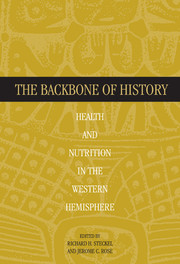Book contents
- Frontmatter
- Contents
- Preface
- List of Contributors
- PART I
- PART II METHODOLOGY
- PART III EURO-AMERICANS AND AFRICAN-AMERICANS IN NORTH AMERICA
- PART IV NATIVE AMERICANS IN CENTRAL AMERICA
- Introduction
- 10 Social Disruption and the Maya Civilization of Mesoamerica: A Study of Health and Economy of the Last Thousand Years
- 11 Health and Nutrition in Pre-Hispanic Mesoamerica
- PART V NATIVE AMERICANS AND EURO-AMERICANS IN SOUTH AMERICA
- PART VI NATIVE AMERICANS IN NORTH AMERICA
- PART VII
- PART VIII
- PART IX EPILOGUE
- Index
11 - Health and Nutrition in Pre-Hispanic Mesoamerica
Published online by Cambridge University Press: 01 March 2010
- Frontmatter
- Contents
- Preface
- List of Contributors
- PART I
- PART II METHODOLOGY
- PART III EURO-AMERICANS AND AFRICAN-AMERICANS IN NORTH AMERICA
- PART IV NATIVE AMERICANS IN CENTRAL AMERICA
- Introduction
- 10 Social Disruption and the Maya Civilization of Mesoamerica: A Study of Health and Economy of the Last Thousand Years
- 11 Health and Nutrition in Pre-Hispanic Mesoamerica
- PART V NATIVE AMERICANS AND EURO-AMERICANS IN SOUTH AMERICA
- PART VI NATIVE AMERICANS IN NORTH AMERICA
- PART VII
- PART VIII
- PART IX EPILOGUE
- Index
Summary
ABSTRACT
Central Mexico witnessed the development and florescence of pre–Columbian Mesoamerican complex societies for over two thousand years, including several urban civilizations and centers of influential empires. Using four skeletal samples that span the Mesoamerican sequence from an early ranked village to a Post classic urban society, we trace the health effects of living in such an arid highland environment. The small skeletal samples available here cannot provide more than hints as to quality of life, but comparisons with other hemispheric samples indicate that health problems are always present. There is moderate morbidity in the earliest, most simple society; however, as populations became more dense, urban, socially stratified, and militaristic, there is a general trend to greater burdens of morbidity through time as reflected in the various health indicators. Future research is needed to test the broad pattern of change portrayed here in this first attempt to look at the quality of life for all of pre–Columbian Central Mexico.
INTRODUCTION
Mesoamerica has been an important area for archaeological research for some time. Despite the amount of information that we have from these ancient societies, whether from small or grand monumental sites, our knowledge about their inhabitants is less developed: how they lived, what they ate, what kind of health problems they had, or what kind of activities they developed. We think that a helpful means of answering these questions is through the analysis of the way of life of these individuals. Our approach is to study the skeletons, searching for the multicausality of physiological adjustment with the material conditions of existence and lifestyle, which in turn shape culture, habits, and habitat.
- Type
- Chapter
- Information
- The Backbone of HistoryHealth and Nutrition in the Western Hemisphere, pp. 307 - 338Publisher: Cambridge University PressPrint publication year: 2002
- 7
- Cited by



